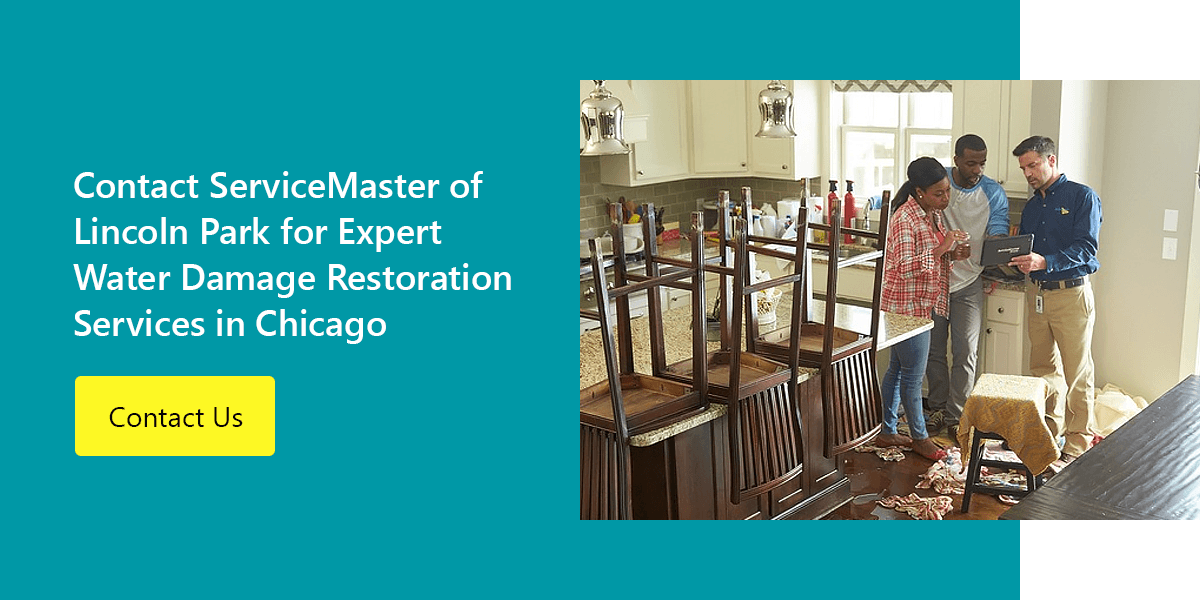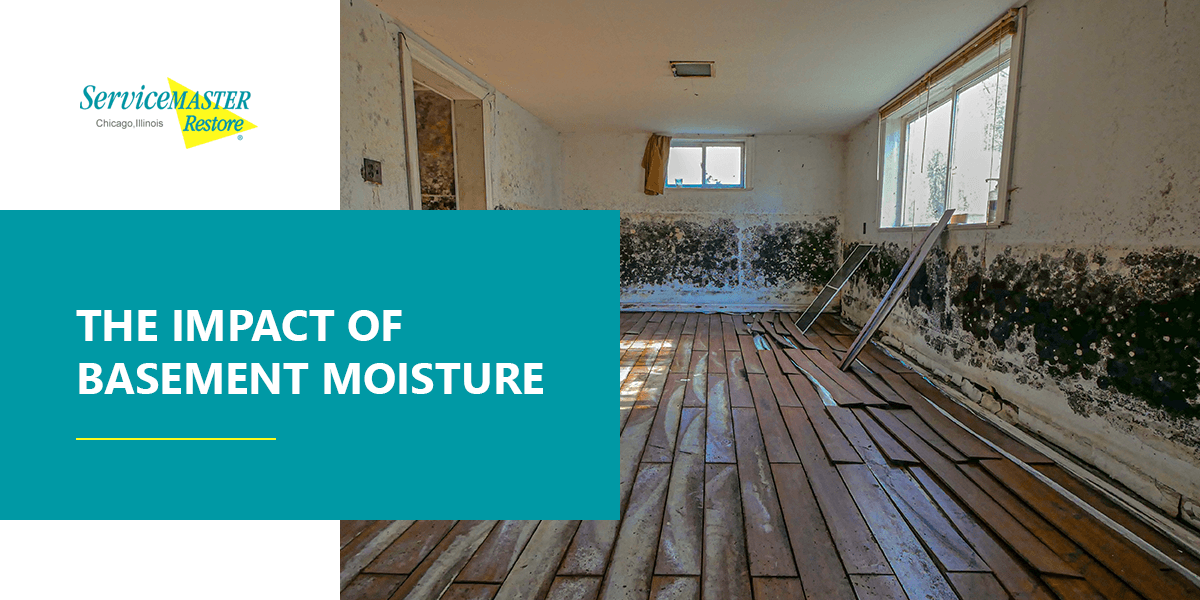
Whether your basement is extra storage space or a finished recreational room, it’s vulnerable to moisture for various reasons. Persistent, undetected basement moisture problems can wreak havoc on your foundation and cause health issues.
The secret to preventing a wet basement is understanding the cause of the issues and what methods you can use to address them. With practical, proactive measures, you can keep your basement dry and safe for whatever purpose you choose.
What Causes a Wet Basement?
Basements are below-grade rooms, meaning they’re underground. These rooms’ nature makes them more susceptible to humidity and moisture than other spaces in your home.
Soil surrounds your basement, expanding and shrinking as it absorbs water and dries. The loose soil located around your foundation is particularly susceptible to water absorption. Downspouts often saturate this area during heavy rain, creating a sideways pressure against your foundation.
During expansion, the soil surrounding your basement pushes against your walls, and water pressure rises. This hydrostatic pressure builds against your basement walls, creating cracks, gaps and holes that water can enter. These cracks and crevices in your foundation also allow humid air to enter your home, leading to moisture buildup in your space.
Other common areas for water to enter include the joint where poured concrete meets the wall and any cracks in the mortar joints. Windows can also be a problem in your basement.
To add natural light to basements, builders create cutouts in the foundation for window placement. Then, they make a well around these windows to catch and drain rainwater. There are usually drains built into the base of the well to improve the flow of water.
When these drains are clogged, your window well becomes the perfect place for water to pool. Even if your window is well-sealed, excess water sitting in that well can seep through into the basement. As your windows age and warp, they’re more likely to leak, even when the drain is functional.
Much like the drain in your window well, clogged gutters can also lead to basement moisture problems. While your downspout already feeds rainwater into the loose soil surrounding your foundation, clogged gutters can create a waterfall in this area. When leaves and sticks fill your gutters, water can’t flow to the downspout and pours over the edge instead. Your soil becomes extremely saturated and transfers moisture to your basement.
On the more obvious side of basement moisture, flooding can cause extensive water damage. If you live in a wet region or your home is near a body of water, your basement probably has a sump pump to respond to heavy rainfall. When the sump pump doesn’t operate as it should, flooding may become more common.
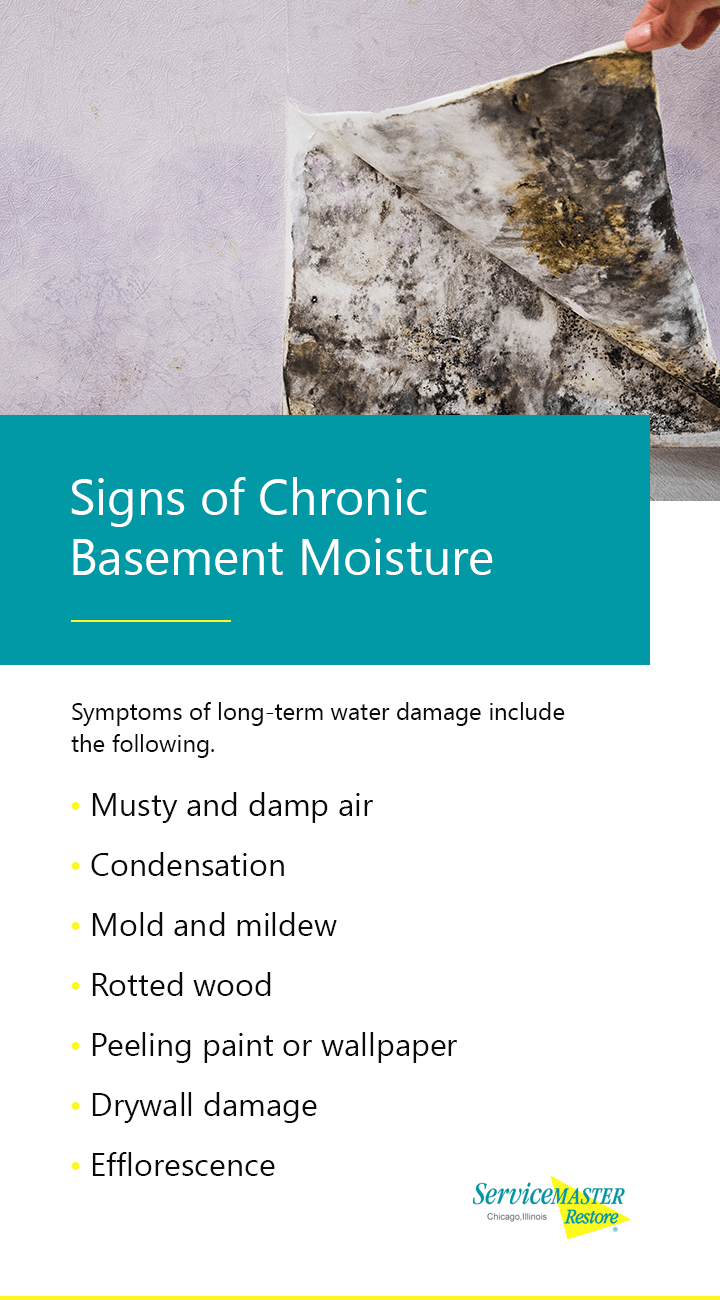
Signs of Chronic Basement Moisture
Basement moisture problems aren’t always evident the minute they start. As moisture builds, you may begin to notice various signs that demand a response. Symptoms of long-term water damage include the following.
- Musty and damp air: Before you start to see physical signs of moisture, you’ll smell and feel it. If moisture damage happens within your walls, it may smell musty in your basement. If it feels damp or humid in your lower level, that’s also a sign your space is wetter than it should be. If you let this damp air linger for too long, it may even travel upstairs and cause further problems.
- Condensation: Do your walls and basement furniture seem to sweat frequently? Moisture buildup, also called condensation, happens when humid air makes contact with a cold surface. While this buildup can occur on a humid summer day, it’s a sign of a moisture problem if it’s frequent.
- Mold and mildew: Mold and mildew on your walls and floors are often some of the first visual signs of basement moisture. When mold first starts to form, it will be white. This early-stage mold is usually the culprit for a musty smell in your basement. As mold gets more severe, it darkens to green and even black, which can cause health problems and be much harder to get rid of.
- Rotted wood: As moisture lingers in the air, it can start to soften materials like wood. Mushy or rotted wood is a sign that your basement is retaining far more moisture than it should. Examine areas like ceiling beams, door frames and windows to look for rot. If this problem sits for too long, it may lead to structural issues that put your house at risk.
- Peeling paint or wallpaper: If you have a finished basement with painted or wallpapered walls, excess moisture can cause staining, peeling and blistering in these areas. These features will likely occur along the floor or around windows before they appear anywhere else.
- Drywall damage: When drywall gets wet, it softens and grows mold. If drywall takes on enough water, it starts to bow and warp, threatening your home’s structural integrity.
- Efflorescence: When stone experiences frequent water and moisture, salt in the material will travel to the surface and create a chalky white buildup called efflorescence. While this material is easy to clean off your walls, it’s a definite sign you have a moisture problem.
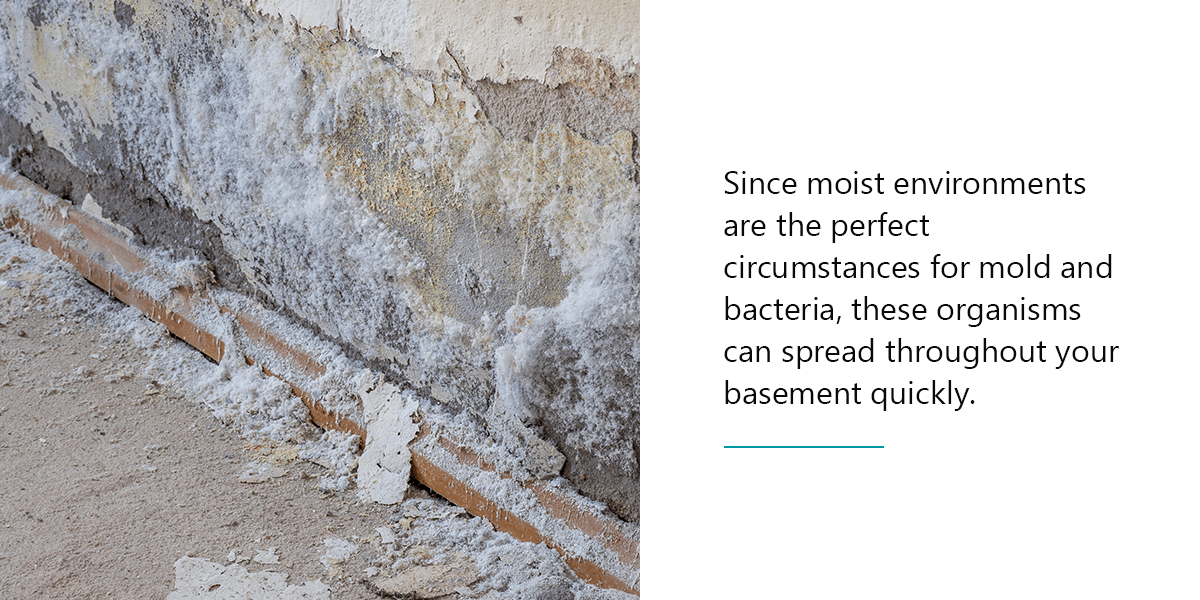
The Health Effects of a Wet Basement
Wet basement health risks can occur when moisture sits for too long. Since moist environments are the perfect circumstances for mold and bacteria, these organisms can spread throughout your basement quickly. They may go unnoticed for a period, giving them more time to spread and contaminate your air.
Mold produces allergens and irritants that cause reactions for people who breathe them in. While not every person reacts to mold, sensitive individuals may experience sneezing, red eyes and skin rash. For people with asthma, mold can trigger an asthma attack. Even non-sensitive individuals can experience irritated eyes, nose and throat.
Moisture also creates an ideal environment for dust mites, which prefer humidity levels at 70 to 80%. While these organisms do not bite or sting, they trigger allergic reactions like coughing, congestion, runny nose and itchy eyes. Asthmatic individuals may encounter more frequent asthma attacks.
While mold and dust mites put those with allergies and asthma at the highest risk, those without these conditions can also experience health problems. The Centers for Disease Control and Prevention have researched the effects of dampness on individuals. Those who spend long periods in damp buildings are more likely to experience:
- Respiratory issues in the nose, throat and lungs
- Respiratory infections
- Bronchitis
- Eczema
- Asthma development
Outside health problems caused by mold, excess moisture can also attract pests. If you have a damp basement, you may find yourself with mice or rats living in the walls, especially since they have access to food in other parts of the home.
While mice and rats are not inherently dangerous, they can carry disease. Coming into contact with infected rodent droppings or breathing in contaminated dust can lead to viral and bacterial infections, like hantavirus pulmonary syndrome and lymphocytic choriomeningitis.
With all the potential health risks that come with basement moisture, you have several reasons to look for these signs and stop them in their tracks. As soon as you notice a problem, contact a professional to help you clear the mold and rid your space of pests.
Does Insurance Cover Basement Water Damage?
Water damage and insurance is a tricky situation because it’s circumstantial. While some water damage falls under your homeowner’s policy, other types require a different policy or lack coverage completely.
Most of the water damage homeowner’s insurance will cover involves broken appliances and other mechanical features inside the home. For example, a broken refrigerator may cause excess leaking that damages the floor and the room below. Your water heater may also leak. In these instances, your insurance coverage will pay for the damages.
There is an exception to this rule. If these leaks resulted from failure to maintain the equipment, you’re responsible, and insurance does not have to cover it. Take excellent care of your appliances to prevent uncovered flooding.
Homeowner’s insurance will also cover a burst pipe caused by freezing temperatures and overflowing in a tub sink or toilet, but only if you are at home when it happens. This rule exists because people often shut off their water or their heat when they travel. In this circumstance, a burst pipe is the result of negligence.
Fortunately, overflowing plumbing is always accidental in the eyes of insurance providers. Whether you have an unpredictable toilet or a child who decides to flood the sink, your insurance company can help with the damages.
Your basic homeowner’s policy does not cover flooding or water damage caused by a rising storm because this incident falls under flood insurance. Specific areas are designated flood zones, and when you live in one, flood insurance is usually a requirement.
If you’re not in a flood zone, flood insurance may be pricier than it’s worth for your circumstances. The best way to control potential flooding is to have a sump pump in your basement. Some companies will offer additional sump pump coverage with your homeowner’s policy, covering damages that result from a failed pump.
Insurance typically doesn’t cover sewage backup and water seepage. Water seepage may earn coverage if it’s the result of a flood in the area, but if it happens during a regular rainfall, the expenses are your responsibility. The good news is that there are ways to prepare your house for water seepage and redirect rain from your foundation.
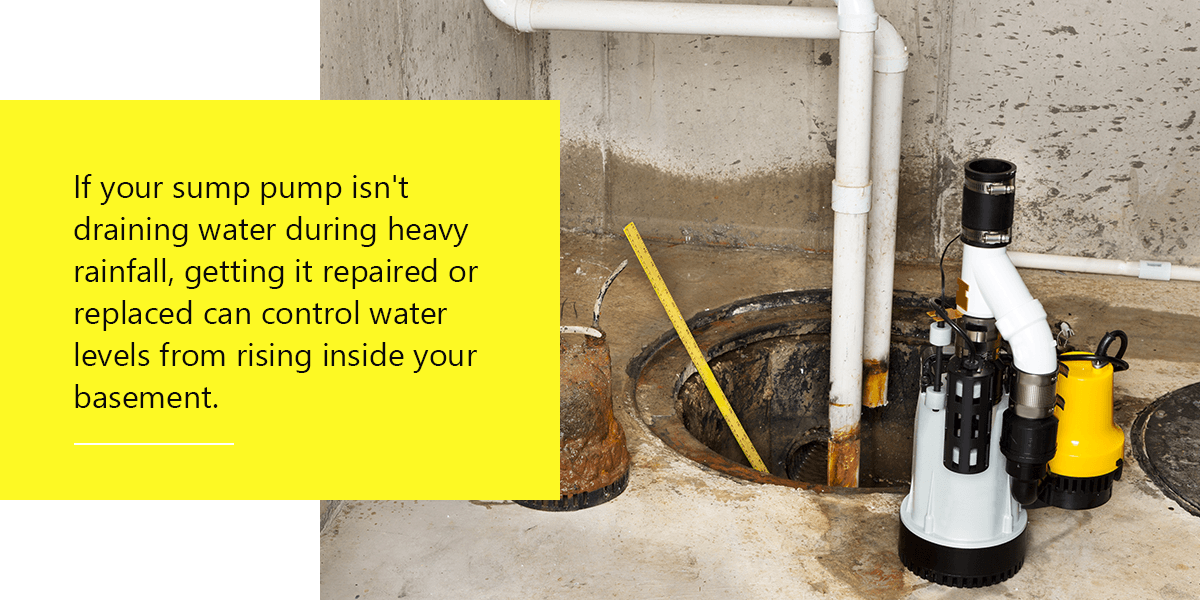
How to Keep Your Basement Dry
Knowing the risks that come with a wet basement can make you want to waterproof your space as much as possible. You can use several practices to keep your basement dry, most of which should become a routine part of your home maintenance.
- Replace or repair your sump pump: If your sump pump isn’t draining water during heavy rainfall, getting it repaired or replaced can control water levels from rising inside your basement.
- Check your downspouts: Downspouts redirect water from the roof to another area in your yard. If your downspouts are too close to the house, they carry rainwater right to the loose soil by your foundation, causing a faster rise in water pressure. Make sure to point your downspouts away from your house so they carry water a reasonable distance from your foundation. You can find tube extensions for these spouts at home and garden stores.
- Clean your gutters: When rain falls, your packed gutters prevent water from flowing through the system and down your spouts. Making a habit of cleaning your gutters a couple of times a year can help you keep debris levels to a minimum. Gutter guards are also an option. These pieces attach to your gutters and filter out debris, so water can continue to flow through your drainage system.
- Modify grading: Building codes require your soil to have a slight grade surrounding your home. If done correctly, the slope will point away from your foundation and rainwater can roll away from your house. If your grade isn’t doing its job, working with a professional can help you fix the problem.
- Fix your window wells: While it’s nice to get a little daylight into your basement, a faulty window well can be causing more problems than it’s worth. Unclogging the drain in your window well and tightly sealing your windows can keep water out.
- Consider indoor drainage: A sump pump may be hard at work in your basement, but you can benefit from other types of indoor drainage. A French drain is a trench with a perforated pipe that runs the perimeter of your basement. It collects water and redirects it away from the foundation, making it easier to reduce moisture levels in the space.
- Repair your foundation: Alleviating pressure buildup with cleaned gutters, downspouts and more can prevent new cracks from forming, but it’s crucial to fix existing damage. A professional can help you patch and reinforce the weakened areas of your foundation to prevent water and humidity from entering your basement.
Contact ServiceMaster of Lincoln Park for Expert Water Damage Restoration Services in Chicago
With an understanding of basement moisture causes and how you can address them, you can keep your basement safe and dry. At ServiceMaster of Lincoln Park, we provide prompt basement water restoration to help you recover from water damage and dampness.
Moisture seeping into your walls, floors and carpet fibers can cause structural issues if left untreated. Our certified technicians are experts at restoring and protecting your space from unexpected water damage.
We’re available around the clock to serve your basement needs. We provide a full range of water restoration services to handle your unique needs. To learn more about our services or start restoration for your basement, contact us online.

